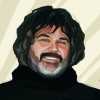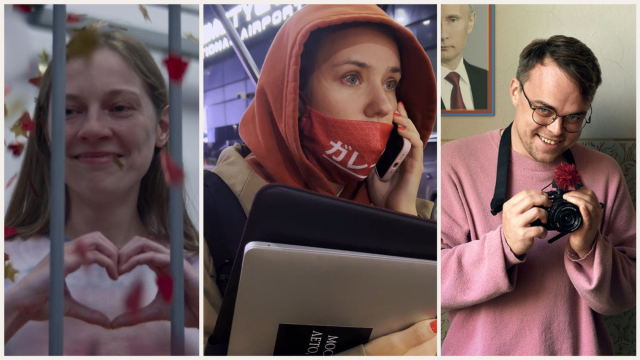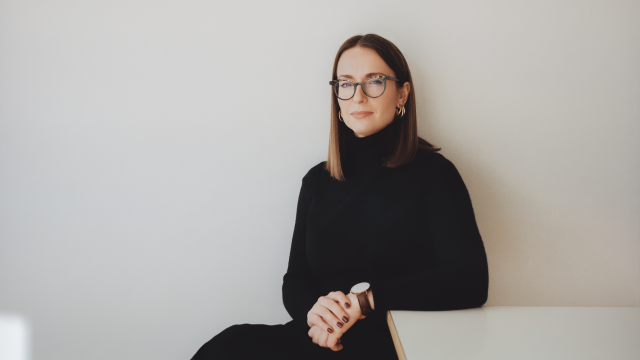All week speakers talked, while directors, designers, actors, sociologists and just-plain-people met to work on a series of short theatrical events that explored the boundaries of performance art. Not surprisingly, the title of the event — one in a series that has been conducted in various forms over the last year — is "Breaking Down Barriers."
It is the brainchild of Georg Genoux, the founder of Moscow's Joseph Beuys Theater, and Mikhail Kaluzhsky, a journalist who has staged and organized numerous theatrical or paratheatrical events. For the current set of lectures, rehearsals and showings, they also enlisted the services of friends and colleagues Pavel Rudnev and Alyona Karas, both of whom are respected critics and theater activists.
I attended a five-hour session on Saturday that consisted of three vastly different projects.
The evening began as director Pavel Artemyev claimed he was inviting a woman from Chelyabinsk onstage to discuss her Russian Orthodox faith, as well as her fears that Russia and Russian Orthodoxy are under attack from other religions and from those who have strayed from the true faith. Over the course of 20 minutes, the woman made numerous controversial statements and quickly came under fire from audience members shooting back equally controversial, if not insulting, commentary.
To many in the hall it was clear from the outset that we were witnessing a game. This was, after all, a theatrical project and the director explained that materials for his performance were gathered through interviews and research. Most of the comments from audience members were markedly literate, not at all the kind of thing a stray spectator would say on his or her own. Clearly, some were more prepared for this event than others. Moreover, the director repeatedly confused the name of the woman standing up for religion, at times calling her Vera, as she was introduced, at times slipping (presumably on purpose) and calling her Yulia.
Her real name, as it turned out, is Yulia Polevaya, and she is a religion scholar who participated in the making of the project.
More than a few in the hall believed the ruse and it was these individuals who ratcheted up the confrontational tone of the performance. It even descended at one point to a shouting match between two women, one who was attacking the logic of the speaker on stage, the other who was offended by what she perceived to be a complete lack of simple human courtesy.
For me, at least, this experiment in playing with the clichés of religion and intolerance was more interesting as an exercise in what people are willing to accept as "real" on a stage. As "theater," the arguments about religion and faith, for all their erudition, struck me as common and obvious. What engaged me was observing how some people are willing to cross an invisible line between what is acceptable and what is not, while others are not. Put simply, do you see through a hoax or not? Do you accept the rules of a game and play along? And, if you do, are you willing to engage in the inevitable conflicts with others who, for whatever reasons, do not accept those rules?
Next up was "Cherkisov Revisited," a performance-installation, if I may put it that way, conceived by Felix Meyer-Christian, Eylien Konig, Karolina Mazur and Alexei Kukarin. This was ostensibly an exploration of the effect that the controversial closing of the Cherkizovsky open-air market had on those who had worked there, although nothing so obvious and concrete emerged from the performance we witnessed. It included documentary texts drawn from interviews with a former market worker, and excepts from the writings of Chingiz Aitmatov.
The audience wandered about the stage, stopping to peruse a sculptural ensemble of pedestals in the center of the hall; to watch excerpts from Andrei Tarkovsky's film "Stalker" on a computer in one corner; to watch videos of the old Cherkizovsky market projected on the floor in another corner; to listen to a women reading text in Polish as a Russian interpreter provided simultaneous translation; and to observe an oversized polyethylene bag as it came to life and crawled across the floor.
There was no center of attention and, during a discussion afterwards, director Meyer-Christian admitted he was surprised and even a little disappointed that some elements of his work were basically ignored by spectators. Much was made of the odd figure of the sack making its way across the floor. Some were surprised that no one bothered to open the bag and look inside — clearly there was a person in there, perhaps someone who needed to be liberated. Others pointed out that some spectators stood in the way of the bag and hindered its forward movement. Was this an act of curiosity, indifference or hostility?
The liveliest discussion followed the performance of a piece mounted by Veronika Ponamaryova with the assistance of Anastasia Osankina. It posited a young man with cerebral palsy (Kirill Golyshev) sitting on a bench with an actress playing his mother. The young man did nothing but pop bubbles on a huge swath of bubble wrap while his mother scurried around him, talking to him, talking to herself, busying herself pulling out jars of canned vegetables and generally trying to make herself useful to her son. The mother's muttering was mostly drowned out by a recording of an introspective text that Golyshev had written.
Some were concerned that Golyshev was exploited as an object. Others complained that the topic of the sketch was not art, but was lowly journalism. Others were upset that they heard neither the text of the mother nor the son because each cancelled the other out. Still others found the piece to be a moving depiction of the way that love is expressed through the tiniest, most mundane human actions.
How much "theater" did I witness in these three projects? I'm not sure I can answer the question. I am tempted to say, "Little." And yet, what I saw was the extremely lively and variegated response of spectators. This, more than actual "theater," seemed to me to be the territory of the experiments. What does a theater artist expect of a spectator? What does a spectator expect to see on a stage? How far from his or her expectations is a spectator willing to stray and still agree that theater is theater?
These may sound like esoteric questions when posited in writing. But that, I would say, is where the "Breaking Down Barriers" project made its mark: it worked out theories in practical surroundings, giving us concrete evidence that theater may be a more amorphous concept than we are usually willing to admit.
A Message from The Moscow Times:
Dear readers,
We are facing unprecedented challenges. Russia's Prosecutor General's Office has designated The Moscow Times as an "undesirable" organization, criminalizing our work and putting our staff at risk of prosecution. This follows our earlier unjust labeling as a "foreign agent."
These actions are direct attempts to silence independent journalism in Russia. The authorities claim our work "discredits the decisions of the Russian leadership." We see things differently: we strive to provide accurate, unbiased reporting on Russia.
We, the journalists of The Moscow Times, refuse to be silenced. But to continue our work, we need your help.
Your support, no matter how small, makes a world of difference. If you can, please support us monthly starting from just $2. It's quick to set up, and every contribution makes a significant impact.
By supporting The Moscow Times, you're defending open, independent journalism in the face of repression. Thank you for standing with us.
Remind me later.






